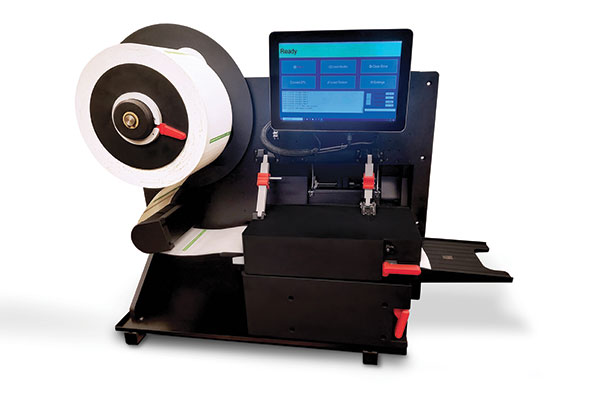Interested in knocking 40% off your shipping label costs?
That would probably be a yes. Here’s the story of a new, double-sided linerless label printer that promises to do just that.

Ever wonder what they talk about in the development lab of a label printer company? Probably not. That goes for me, too.
What follows is the story of an observation by such a team that stands to directly impact your packing and shipping operation, especially if it’s volume-based, high-demand distribution.
Toshiba’s Lake Forest, Calif., development team saw a gap in the market for dual-sided printers. That was about the time the company discontinued its own dual-sided printer, which was not suited to the increasing demands of e-commerce operations, explainsJessica Bernardo,Toshiba America Business Solutionssenior product marketing manager for bar code and label print solutions.
“They saw issues in the market and set out to solve them,” Bernardo explains. Which is kind of a weird twist considering the product cancellation. But then again, maybe this was a matter of the development team seeing a need and realizing the company could build an even better product. Now, that’s a gutsy observation, especially in the early days ofCovid.
要求的病例是如此引人注目,high-growthe-commerceenvironments needed something more than what existed in the market then. So, Toshiba Japan sanctioned the U.S. team to move ahead with the development of a dual-sided, linerless printer. And they did. In fact, the printer has been shown as a concept at recent Pack Expo and Modex shows.
What is it? A four-inch thermal transfer/direct thermal duplex printer. It produces a linerless, double-sided (duplex) pack slip label at 6 inches per second. Front and back are printed simultaneously.
What it does. It eliminates the need for two printers for shipping and packaging labels. By combining the two labels into one without a liner, label costs fall 40%. In an operation that ships half a million boxes monthly, that’s an annual savings of roughly $135,000, says Bernardo.
Why it matters. “The printer promotes environmental sustainability by eliminating the liner while boosting productivity by reducing the time required to match and adhere packing materials and using less hardware in the process,” says Bernardo.
Now for the story behind the story. While the development team had the right ideas, it didn’t have all of the right technologies to accomplish everything Bernardo just described. So, the team went outside for some help.
The linerless label technology is from Premier. Yes, it is patented. The two-sided labels eliminate the need for a shipping label, a packing list and a plastic pouch on each box (see photo). And, to reiterate, the labels are linerless, eliminating the need to peel and stick as well as the liner waste.
Beyond eliminating the need for two printers for every shipment, this solution shrinks the footprint of the labeling operation in the packaging department. It also eliminates the need for people to coordinate printing and application of labels. The printer will also be available with an automated applicator system by Panther Industries.
By the way, says Bernardo, the combination of the linerless labels and the print engine is no bolt on. The two were designed to complement each other to maximize operational performance and cost savings. So, that’s what a label printer development team does. Now we all know.

Article Topics
Packaging News & Resources
Optimizing S&OP for CPG & Retail: Visibility and Agility for Fast Changing Markets Gaining Crucial Business Insights Through Supply Chain IoT How to Keep Packaging from Becoming the Weak Link in Supply Chain Digitalization Harness the Strategic Power of Labeling Packaging is the major theme of ProMatDX Day 3 2021 Top 5 Trends in Labeling ProMat goes digital with ProMatDX 2021 More PackagingLatest in Logistics
LM reader survey points to strong possibility of the economy entering into a recession August intermodal volumes see another month of declines, reports IANA National diesel average rises for the ninth consecutive week, reports EIA August Cass Freight Index shipments and expenditures fall annually and rise sequentially OOIDA bucks effort to regulate heavy truck speeds Rivals pick over old Yellow freight assets as shippers plan for LTL rate hikes U.S. rail and intermodal volumes are mixed, for week ending September 9, reports AAR More LogisticsAbout the Author
Subscribe to Logistics Management Magazine

Find out what the world's most innovative companies are doing to improve productivity in their plants and distribution centers.
Start your FREE subscription today.
September 2023
万博2.0app下载

Latest Resources






